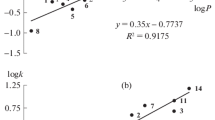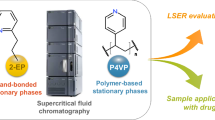Abstract
The influence of temperature on the retention behavior of epirubicin and its analogues on high purity silica with reversed-phase solvents has been systematically investigated. It was found that temperature effects on retention are highly dependent on the type and concentration of organic modifier, as well as the pH of the mobile phase. In organic-rich mobile phases, the type of organic modifier plays an important role. With an aprotic solvent as modifier, retention times show anomalous increases with elevated temperature. At the same time, both efficiency and resolution are significantly improved but this is not the situation with a protic solvent as modifier. In addition, temperature shows different effects on retention time and selectivity when the pH is changed, and temperature-dependent selectivity reversal is found at higher pHs. In aqueous-rich mobile phases, regardless of the nature of the organic solvent and pH, retention of solutes drops as temperature is raised. It seems that the effect of temperature on chromatographic behavior of the solutes on bare silica using mobile phases containing various organic modifiers or pHs, results from a number of different retention mechanisms.








Similar content being viewed by others
References
Li JW, Carr PW (1997) Anal Chem 69:2193–2201
Yang XQ, Ma LJ, Carr PW (2005) J Chromatogr A 1079:213–220
Li J (1998) Anal Chim Acta 369:21–37
Dolan JW (2002) J Chromatogr A 965:195–205
Chester TL, Coym JW (2003) J Chromatogr A 1003:101–111
Claessens HA, Straten MA (2004) J Chromatogr A 1060:23–41
Castells CB, Gagliard LG, Ráfols C, Rosés M, Bosch E (2004) J Chromatogr A 1042:23–36
Buckemaier SMC, McCalley DV, Euerby MR (2004) J Chromatogr A 1060:117–126
Gagliardi LG, Castells CB, Ráfols C, Rosés M, Bosch E (2005) J Chromatogr A 1077:159–169
McCarthy JP (1994) J Chromatogr A 685:349–355
Lee W, Cho D, Chun BO, Chang T, Ree M (2001) J Chromatogr A 910:51–60
Crommen J (1979) J Chromatogr 186:705–724
Svendsen H, Greibrokk T (1981) J Chromatogr 212:153–166
Bidlingmeyer BA, Del Rios JK, Korpi J (1982) Anal Chem 54:442–447
Law B (1990) Trends Analyt Chem 9:31–36
Bidlingmeyer BA, Henderson J (2004) J Chromatogr A 1060:187–193
Guo Y, Gaiki S (2004) J Chromatogr A 1074:71–80
Naidong W (2003) J Chromatogr B 796:209–224
Qi Y, Huang JX (2001) J Liq Chromatogr Relat Technol 24:2837–2848
Melander W, Campbell DE, Horváth C (1978) J Chromatogr 158:215–225
Zhuravlev LT (2000) Colloids Surf A Physicochem Eng Asp 173:1–38
Li RP, Huang JX (2004) J Chromatogr A 1041:163–169
Nawrocki J, Rigney RP, McCormick A, Carr PW (1993) J Chromatogr A 657:229–282
Buckemaier SMC, McCalley DV, Euerby MR (2004) J Chromatogr A 1026:251–259
Li RP, Huang JX (2005) J Liq Chromatogr Relat Technol 28:2737–2751
Author information
Authors and Affiliations
Corresponding author
Rights and permissions
About this article
Cite this article
Dong, L., Huang, J. Effect of Temperature on the Chromatographic Behavior of Epirubicin and its Analogues on High Purity Silica Using Reversed-Phase Solvents. Chroma 65, 519–526 (2007). https://doi.org/10.1365/s10337-007-0200-3
Received:
Revised:
Accepted:
Published:
Issue Date:
DOI: https://doi.org/10.1365/s10337-007-0200-3




